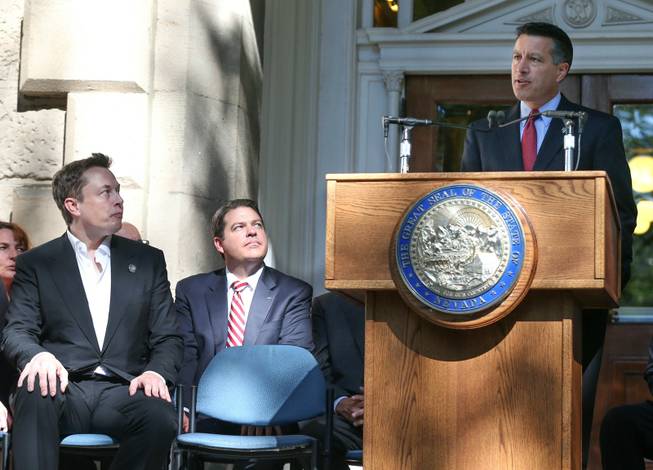
Cathleen Allison / AP
Nevada Gov. Brian Sandoval announces that Nevada was chosen as the new site for a $5 billion Tesla Motors car battery factory, during a press conference at the Capitol in Carson City, Nev., on Thursday, Sept. 4, 2014. Tesla CEO Elon Musk, left, also spoke about the gigafactory his company will build east of Reno, bringing an estimated 6,500 jobs. (AP Photo/Cathleen Allison)
Friday, Sept. 5, 2014 | 2 p.m.
A version of this originally appeared on the Brookings Institution’s Avenue blog.
Nevada Gov. Brian Sandoval looked pretty happy Thursday when he announced Tesla Motors had chosen Reno as the site for its proposed $5 billion “gigafactory” battery plant.
As well he might:
While the $1.3 billion potential cost of the state’s attraction package could haunt the state, the win is clearly huge.
Not only does the announcement make Nevada the winner of the highest-profile industrial siting war in years, but it promises to generate up to 6,500 new jobs in what could become one of the largest single factories in the United States.
Moreover, the arrival of Tesla will soon give the state a major new presence in a critical sector: high-value, clean tech manufacturing.
As such, the siting represents a significant step forward for the state’s ongoing economic diversification campaign, as informed by the Metro Program, Brookings Mountain West, and SRI International with the 2011 strategy report.
A state that paid a high price in the crash for its overreliance on tourism, gaming and real estate as its economic mainstays now has the mother of all opportunities to accelerate the build-out of a new, more varied and better-paying economy.
Which means Nevadans should gloat for maybe a day or two (OK, a week!) — and then get to work leveraging the opportunity of the gigafactory. To do that, the state should think urgently and right away how to boot-strap its present good fortune into permanent, self-perpetuating and broader advantage in advanced industries.
Here are three strategies:
Pile onto workforce training and education. The first priority for Nevada has to be: Train, train, train.
Educate, educate, educate.
By all reports, the Tesla plant is going to require thousands of “middle skill” assembly workers, operators and maintenance technicians, as well as hundreds of engineers, technically alert supervisors and technicians.
That will be welcome to a state that was hammered during the crisis.
And the great news is many of the jobs at the gigafactory will be accessible to the state’s young high school graduates.
However, the numbers involved alone will challenge Nevada, as will the state’s relatively thin cadre of STEM (science, technology, engineering and math)-skilled workers.
Given that, the state and its regions should use the gigafactory’s arrival to kick-start a major workforce training and STEM education campaign aimed at turning the urgency of near-term hiring needs into a longer-term habit of preparation — not just in Reno but statewide.
At the center of this should be a statewide push to promote the importance of STEM skills-building aligned to the specific needs of the state’s industries.
Such a push would do more than anything else to convert the Tesla opportunity into a lasting sea change.
Build the ecosystem. Nearly as important as building a superb STEM-trained skills base in Nevada to support the gigafactory and further high-quality growth is the need to build up the state’s regional industrial ecosystems.
The arrival of the gigafactory will bring with it a need for numerous suppliers and service providers, new and existing.
Those firms can then — if nurtured — emerge as the base of a denser industrial ecosystem in Nevada that will yield further opportunities in other industries.
To the extent, then, the state and its regions help foster the emergence of vibrant, varied and nimble industrial clusters across the state, they will make the most of the coming Tesla supply chain.
Commit to innovation. Finally, the state should seize this moment to set a platform for higher-value growth in Nevada through technology-development and innovation.
Innovation, after all, remains the only lasting source of advantage both for high-value firms and high-wage locations.
However, Nevada — as the 2011 economic development strategy noted — has much work to do construct a serious presence in technology-based economic development.
Significant investment in the university system’s research and technology programs is going to be essential if the state is going to boot-strap true technology competitiveness.
So are investments in “impact scholars” and university-industry research and technology collaborations.
Only in that way will the state build the kind of synergistic R&D relationships with Tesla, it suppliers and future tech arrivals.
The bottom line:
Nevada — a state that has suffered mightily since the crisis — has worked hard to secure a huge opportunity to improve its economy for good.
Now it should turn to building lasting advantage.
Mark Muro is co-director of Brookings Mountain West and senior fellow and policy director of Metropolitan Policy Programs at the Brookings Institution.

Join the Discussion:
Check this out for a full explanation of our conversion to the LiveFyre commenting system and instructions on how to sign up for an account.
Full comments policy